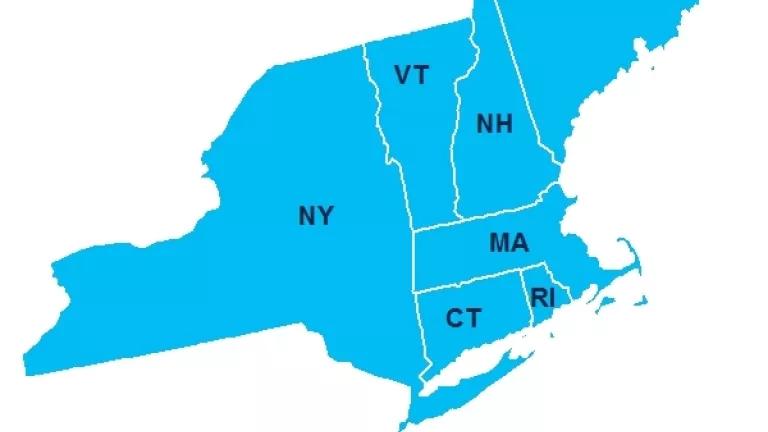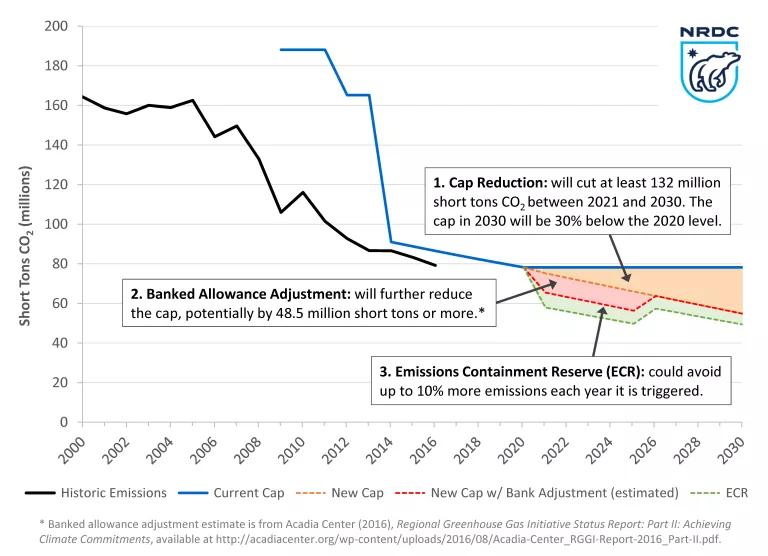RGGI Agrees to Cut Power Plant Pollution by Another 30%

A bipartisan coalition of nine Northeastern and Mid-Atlantic states today agreed to a bold plan to cut power plant pollution by at least another 30 percent through 2030, reaffirming the groundbreaking leadership of the Regional Greenhouse Gas Initiative (RGGI) in the face of the Trump administration’s abandonment of climate progress.
The plan tightens the emissions cap in the nation’s first market to cut carbon pollution. Connecticut, Delaware, Maine, Maryland, Massachusetts, New Hampshire, New York, Rhode Island, and Vermont undertook a 21-month review to determine how much more climate-changing pollution from power plants to cut—and how fast—beyond 2020.
Today’s announcement means that by 2030, at least 132 million more short tons of carbon pollution will be avoided, equivalent to avoiding one-year’s worth of emissions from over 25 million cars. In 2030, the regional cap on power-sector emissions will be 65 percent lower than in 2009, RGGI’s first year. Additional mechanisms could further cut carbon pollution by tens of millions of tons more.
The agreement tracks New York Governor Andrew Cuomo’s call earlier this year for a 30 percent cut in RGGI’s cap. The states also outlined a package of key reforms to ensure RGGI realizes its potential to deliver the planned carbon reductions while delivering significant economic and public health benefits to the region. The states will present additional details on their plan, including economic modeling results, and take comments at a public stakeholder meeting on September 25 in Baltimore, Maryland.
Following California’s recent adoption of bipartisan legislation to extend its carbon market, today’s announcement by nine RGGI states that together represent the world’s sixth-largest economy is another powerful rebuke to the Trump administration’s dangerous denial of climate change and a strong signal to the rest of the world. With New Jersey and Virginia likely to join RGGI’s carbon market in the near future, the pollution reductions and economic and public health benefits from this program are also primed to expand.
How RGGI Works
RGGI sets a regional limit, or cap, on carbon pollution from the region’s power plants. The cap declines annually—reducing total pollution—and is enforced by selling a decreasing number of permits, known as allowances, via quarterly auctions. Owners of polluting power plants purchase the allowances, or trade for them in the market, to account for their emissions.
The RGGI states invest the auction revenues in programs that benefit consumers. Since 2009, these investments have helped RGGI:
- Save consumers $618 million on energy bills, with billions more expected, thanks to energy efficiency and renewable energy investments
- Provide public health benefits valued at $5.7 billion by also cutting other dangerous air pollutants like soot and smog alongside carbon;
- Contribute at least $2.9 billion in regional economic growth; and
- Boost regional employment by more than 30,000 job-years (one year of full-time employment for one person).
Meanwhile, electricity prices in the region have fallen by 3.4 percent, even as they have increased in other states. And the region’s economy has grown by 25 percent, outpacing non-RGGI states, even as emissions have fallen faster in RGGI than in other regions. Since RGGI launched, carbon pollution from the region’s power plants has fallen by more than 40 percent.
With a record like this, it’s no wonder the RGGI governors are ready to do more. Analyses by NRDC and others show a tighter RGGI cap will provide more money for state clean energy programs that save consumers money. It will also provide more public health benefits and create more jobs.
Even More Carbon Cuts

Today’s agreement includes two important mechanisms that could lead to even more carbon reductions: a banked allowance adjustment to the cap, and additional low-cost reductions captured under a new Emissions Containment Reserve (ECR).
Banked Allowance Adjustment: Making a fix here will mean even more pollution reductions, although we won’t know exactly how much until 2021. RGGI’s current cap didn’t anticipate that emissions would fall faster than required because of market trends like rapidly falling costs of renewable energy and energy efficiency, low natural gas prices, and increasingly ambitious state clean energy policies. This resulted in more allowances being sold than the market needs, and the unused allowances being “banked” for use in future years. If unaddressed, power plants could use these banked allowances to pollute more than the states’ proposed cap post-2020.
To prevent this, the states will further lower RGGI’s cap in 2021-2025 by the amount of excess allowances sold and banked between 2014 and 2020 (the same approach previously used to address banked allowances from 2009-2013). Our friends at Acadia Center estimate this could avoid an additional 48.5 million tons of carbon pollution (or more).
Emissions Containment Reserve (ECR): The states also announced an ECR, an exciting new tool that will automatically lower RGGI’s cap, by up to 10 percent a year, whenever allowance prices fall below expected levels. Since RGGI launched, carbon reductions have consistently cost less than expected. By providing a mechanism to capture more of these low-cost emissions reduction opportunities, this innovative tool—the first-of-its-kind in emissions trading markets—could potentially get to the even deeper emissions reductions that NRDC and other groups urged the states to adopt.
We are pleased the states also proposed reforms to RGGI’s Cost Containment Reserve (CCR), which is broken, and has undermined climate benefits by unnecessarily releasing new allowances above the cap. The proposed reforms will make it less likely the CCR is triggered in the coming years, and that fewer allowances are released with the CCR is triggered. We encourage the states to also restructure the CCR so it “borrows” allowances from future years, rather than adding them above the cap.
Decision in Perspective
By committing to strengthen their program, the RGGI governors (five Republicans, four Democrats) are showing that bipartisan climate progress is thriving in their economically and geographically diverse region. Since RGGI launched, each state, except Delaware, has been led by both Republican and Democratic governors. With this important commitment to continue cutting power sector carbon pollution, the states can build on their momentum to begin tackling the next climate challenge: to address the excessive amount of vehicle pollution in the region.
Preventing the worst impacts of climate change requires all hands—and political persuasions—on deck. President Trump may reject U.S. environmental leadership (and science, and reality for that matter), but RGGI and states like California are forging ahead to fill the leadership void and establishing bold models for others to follow.

